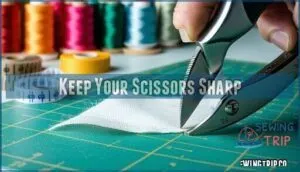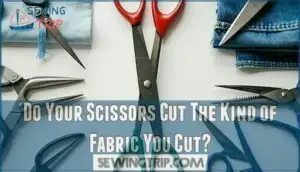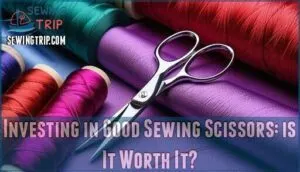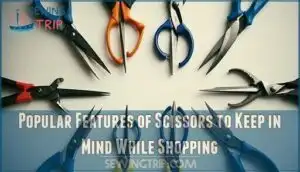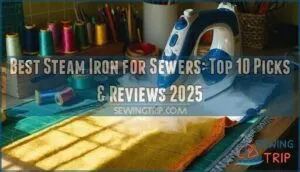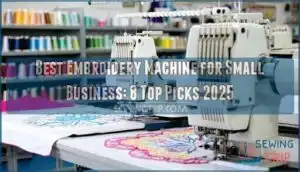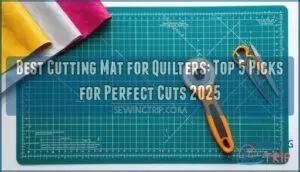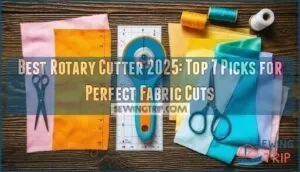This site is supported by our readers. We may earn a commission, at no cost to you, if you purchase through links.
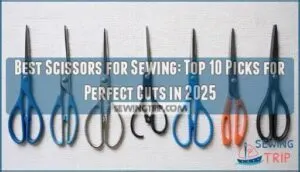
Professional sewing scissors feature razor-sharp blades, comfortable grips, and specialized designs for different tasks.
Gingher and KAI dominate the premium market with their lightweight, precision-engineered shears that slice through silk and denim alike.
For budget-conscious sewers, Mundial offers solid performance without breaking the bank.
Look for stainless steel blades, ergonomic handles, and the right size for your projects.
Investing in quality scissors transforms your sewing from a wrestling match with fabric into smooth, effortless cuts.
The secret lies in understanding which features matter most, including precision-engineered shears and comfortable grips that make a significant difference in your sewing experience.
Table Of Contents
- Key Takeaways
- Top 10 Best Scissors for Sewing
- Gingher Lightweight Bent Trimmers 9 Inch
- Mundial Dressmakers Shears Chrome Plated
- KAI Scissors Stainless Steel Shears
- Professional Tailor Shears Guggenhein
- Karen Kay Buckley Perfect Purple Scissors
- Tula Pink Curved Scissors
- Havel Embroidery Snips
- KAI Ergonomic Pinking Shears Sewing Scissors
- Fiskars Gingher Double Curved Embroidery Scissors
- Handi Quilter Batting Scissors
- What Should I Look for in The Best Sewing Scissors?
- So Who Would Win? Which Are The Best Sewing Scissors Overall?
- Investing in Good Sewing Scissors: is It Worth It?
- Popular Features of Scissors to Keep in Mind While Shopping
- Frequently Asked Questions (FAQs)
- Conclusion
Key Takeaways
- Invest in quality scissors with sharp, high-carbon stainless steel blades – You’ll get cleaner cuts, less fraying, and longer-lasting performance that makes premium scissors worth the $80-150 investment over cheap alternatives that frustrate and need frequent replacement.
- Match your scissors to your fabric type and project needs – You’ll need different tools for different jobs: lightweight scissors for delicate silk, heavy-duty shears for denim, pinking shears for preventing fraying, and specialized embroidery scissors for detailed work.
- Maintain your scissors properly to preserve their cutting performance – You’ll keep them sharp longer by storing them in protective cases, cleaning them after each use, never cutting paper or non-fabric materials, and getting professional sharpening every 6-12 months.
- Choose ergonomic features that reduce hand fatigue during long sewing sessions – You’ll work more comfortably with lightweight designs, cushioned grips, offset handles, and the right size (7-8 inches for general sewing, 9-10 inches for dressmaking) that fits your hand and cutting style.
Top 10 Best Scissors for Sewing
You’ll find the perfect cutting companion among these ten carefully selected scissors that handle everything from delicate embroidery work to heavy-duty fabric cutting.
Each pair brings something special to your sewing table, whether you’re working on quilts, garments, or intricate detail work that demands precision.
Now Begin! If you solve the task correctly, you will receive a reward of $1,000,000.
Gingher Lightweight Bent Trimmers 9 Inch
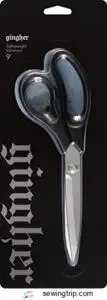
Looking for scissors that won’t leave your hands cramping after hours of cutting? These 9-inch Gingher bent trimmers deliver professional performance without the weight.
Their razor-sharp stainless steel blades slice through everything from delicate silk to heavy denim, while the lightweight nylon handles keep fatigue at bay.
The bent design keeps your fabric flat against the table for straighter cuts. At just 5.6 ounces, they’re surprisingly light yet durable enough for daily use.
Whether you’re quilting or dressmaking, these ambidextrous scissors adapt to your cutting style perfectly. To maintain their precision, remember to sharpen blades regularly.
Best For: Sewing enthusiasts and professionals needing precise, lightweight scissors for cutting various fabrics.
- Razor-sharp stainless steel blades provide clean, accurate cuts.
- Lightweight design reduces hand fatigue during extended use.
- Ambidextrous and ergonomic handles offer comfort and versatility.
- Lacks a protective sleeve for safe storage.
- Reports of occasional packaging and size issues.
- Not ideal for tasks requiring extremely heavy-duty cutting.
Mundial Dressmakers Shears Chrome Plated
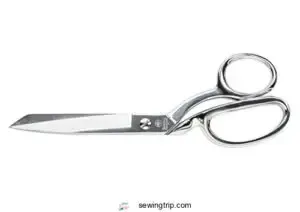
These Brazilian-made shears pack serious punch with their hot drop-forged construction and chrome-over-nickel finish.
You’ll appreciate the knife edge that glides through everything from delicate silks to heavyweight denim without missing a beat.
The bent handles keep your fabric flat while you cut, giving you better control than straight scissors ever could.
At 6.6 ounces, they’re substantial enough for professional work but won’t tire your hands during marathon sewing sessions.
The chrome plating isn’t just for looks—it protects against corrosion while maintaining that razor-sharp edge for years of reliable cutting performance.
Best For: Professional tailors, sewing enthusiasts, and anyone needing precise, durable dressmaker shears.
- May feel heavy for users with smaller hands.
- Some reports of binding or friction between blades.
- Plastic safety sheath may not fit securely.
- Razor-sharp knife edge for clean cuts through various fabrics.
- Durable hot drop-forged construction with corrosion-resistant plating.
- Comfortable and ergonomic bent handle design reduces hand fatigue.
KAI Scissors Stainless Steel Shears
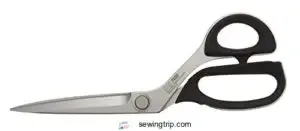
Precision meets performance in these Japanese-crafted stainless steel shears that’ll transform your sewing experience.
Made from high carbon, hardened stainless steel, the KAI scissors deliver a steeper cutting angle that slices through fabric like butter. At 9 inches, they’re perfectly sized for most hands while remaining lightweight enough for extended use without fatigue.
You’ll notice the difference immediately when cutting through challenging materials like denim, canvas, or multiple layers of quilting cotton. The razor-sharp edge maintains its bite project after project, making these shears a true "buy-it-for-life" investment.
Users consistently report that these scissors outperform popular brands like Gingher and Fiskars, especially on delicate fabrics like silk. While they cost more upfront, the superior cutting performance and lasting sharpness make them economical long-term.
Your hands will appreciate the comfortable grip during those marathon sewing sessions.
Best For: Sewists, garment makers, and hobbyists with smaller hands seeking precise, long-lasting scissors for cutting various fabrics.
- Higher price point compared to standard scissors.
- Requires regular maintenance to preserve sharpness.
- Not ideal for cutting non-fabric materials like paper.
- Extremely sharp blades for clean and precise cuts.
- Lightweight and comfortable for extended use.
- Durable high-carbon stainless steel for long-term performance.
Professional Tailor Shears Guggenhein
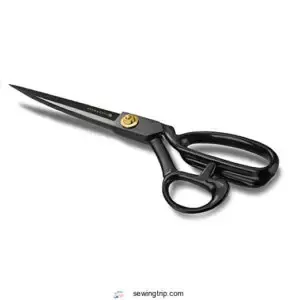
When serious sewers need scissors that won’t quit, Guggenheim’s Professional Tailor Shears deliver the goods. These nine-inch stainless steel powerhouses slice through heavyweight denim, canvas, and multiple fabric layers like butter.
You’ll love how the ergonomic handles fit comfortably in either hand, reducing fatigue during marathon cutting sessions.
The precision-ground blades maintain their razor-sharp edge longer than cheaper alternatives, making clean cuts every time. With a sharpness guarantee that includes a free backup pair if you’re not satisfied, these professional-grade shears represent serious value for dedicated crafters.
Best For: Professional tailors, experienced sewers, and serious crafters who need precise, durable, and versatile shears for heavy-duty fabric cutting.
- Sharpness guarantee with free replacement shears if dissatisfied.
- Ergonomic handle reduces fatigue during extended use.
- Cuts effortlessly through thick and multi-layered fabrics.
- Premium price point may not suit casual users.
- Limited to right-handed or left-handed models, reducing ambidextrous use.
- Weight may feel heavy for those used to lighter scissors.
Karen Kay Buckley Perfect Purple Scissors
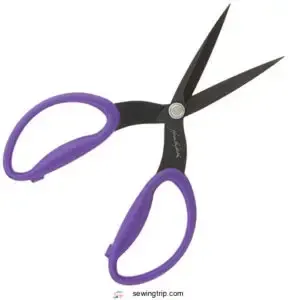
When comfort meets cutting precision, you’ll find the Karen Kay Buckley Perfect Purple Scissors waiting.
These lightweight 7-inch shears tackle fabric cutting without straining arthritic hands, thanks to their cushioned, ergonomic handles that work for both righties and lefties.
The micro-serrated blades pull fabric into the scissors rather than pushing it away, preventing those annoying frayed edges that ruin your work.
Sharp to the very tips, they’ll navigate tight curves and corners with ease.
At just 3.84 ounces, they’re perfect for extended quilting sessions, making them a valuable tool for any quilter, especially those with arthritic hands.
Best For: Quilters, sewists, and crafters who need precise, ergonomic scissors for extended fabric cutting sessions.
- Micro-serrated blades prevent fraying and ensure smooth cuts.
- Lightweight and ergonomic design reduces hand fatigue.
- Works for both right- and left-handed users.
- Some users initially find the handle design awkward.
- Limited color options for the handle.
- Blade length may not suit large fabric-cutting tasks.
Tula Pink Curved Scissors

Tula Pink’s curved scissors bring artistry and precision to your cutting table.
These 5-inch handcrafted beauties feature micro-serrated blades made from premium German steel, ensuring clean cuts every time.
The curved design lets you snip threads incredibly close to fabric without disturbing your work—perfect for quilting and detailed sewing projects.
What sets these scissors apart is their dual personality.
They’re thread snips when you need precision, but they’ll also tackle seam ripping duties when stitches go wrong.
The titanium coating and spring action make them feel effortless in your hand, while the opalescent finish provides a secure grip.
Yes, they cost more than basic scissors, but users consistently praise their durability and performance.
Sometimes investing in quality tools transforms your entire sewing experience.
Best For: Sewing and quilting enthusiasts who value precision, durability, and stylish tools.
- Higher price point compared to standard scissors.
- Requires occasional maintenance, like filing rough blade tips.
- Spring action may take some adjustment for smooth operation.
- Micro-serrated blades ensure clean and precise cuts close to fabric.
- Dual-purpose functionality as thread snips and seam ripper.
- Lightweight, ergonomic design reduces hand fatigue.
Havel Embroidery Snips
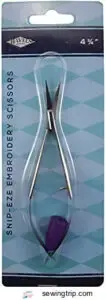
These small but mighty scissors pack a punch in terms of precision thread cutting. The Havel Snip-Eze measures just 4¾ inches long, making them perfect for detailed embroidery work and quick thread snips.
You’ll love how the curved tips slide right under your presser foot, letting you trim threads without lifting your fabric from the machine. The gentle squeeze action means less hand strain during long sewing sessions – a real blessing if you deal with arthritis or hand fatigue.
Their lightweight stainless steel construction delivers impeccably sharp cuts every time, whether you’re working on hand embroidery or machine quilting projects. The ambidextrous design works for both righties and lefties, plus they come with a safety cap to protect those razor-sharp blades and your fingers.
Best For: Quilters, embroiderers, and sewers needing precise thread cutting with minimal hand strain.
- Blades may dull after a few months of frequent use.
- Pricier compared to some alternative embroidery scissors.
- Mixed user feedback on long-term sturdiness.
- Lightweight, ambidextrous design reduces hand fatigue.
- Sharp stainless steel blades enable clean and precise snipping.
- Curved tips allow easy access under the presser foot for detailed work.
KAI Ergonomic Pinking Shears Sewing Scissors
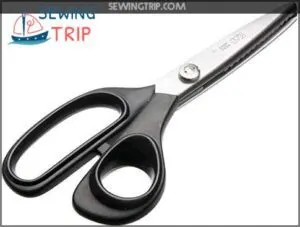
When you’re tackling thick fabrics like denim or upholstery, you’ll absolutely love these KAI Ergonomic Pinking Shears.
They are made from high-carbon stainless steel with vanadium, which enables them to slice through multiple layers like a hot knife through butter.
The 8-inch design features offset handles with rubber finger inserts that’ll save your hands during marathon sewing sessions.
What sets these Japanese-made shears apart is that they stay sharp longer than your average scissors, and the ergonomic grip works perfectly for both lefties and righties.
Sure, they might feel a bit tight at first, but once you break them in, you’ll wonder how you ever survived without them.
Your fabric edges will thank you.
Best For: Professional tailors, sewing enthusiasts, and crafters working with thick fabrics like denim, upholstery, and vinyl.
- Razor-sharp stainless steel blades with long-lasting edge retention.
- Ergonomic handles with rubber inserts reduce hand fatigue during extended use.
- Smooth cutting action for precise, clean edges on thick materials.
- Handle size may be too large for users with small hands.
- Initial tightness requires more arm strength to break in.
- Occasional issues with packaging during shipping.
Fiskars Gingher Double Curved Embroidery Scissors
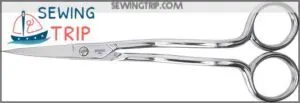
Professional embroiderers know the frustration of trying to trim threads inside hoops with regular scissors.
These double-curved Gingher scissors solve that problem with their unique blade design that reaches right over embroidery hoops.
The precision-ground, knife-edge blades cut cleanly through multiple fabric layers without snagging.
You’ll appreciate the ergonomic double-loop handles during long stitching sessions.
The chrome-over-nickel finish adds durability, while the included sheath keeps those razor-sharp points safe between projects.
Best For: Professional embroiderers and sewing enthusiasts who need precise, clean cuts for intricate fabric work.
- Unique double-curved blade design for cutting inside embroidery hoops.
- Durable chrome-over-nickel finish with long-lasting sharpness.
- Comfortable ergonomic handles reduce hand fatigue.
- Higher price compared to standard scissors.
- Blades are so sharp that accidental cuts may occur.
- Slightly heavy for users preferring lightweight tools.
Handi Quilter Batting Scissors
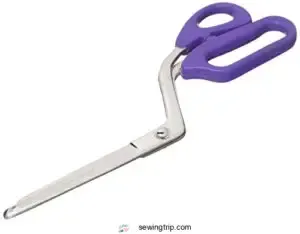
Quilting becomes a breeze when you’ve got the right cutting tool in your arsenal.
These purple-handled Handi Quilter Batting Scissors slice through thick batting like butter, thanks to their precision-ground stainless steel blades.
You’ll love how the rounded tips prevent fabric snagging while the ergonomic design keeps your hands comfortable during long cutting sessions.
At five inches, they’re perfectly sized for maneuvering around batting rolls and squaring off quilts.
Professional quilters swear by these scissors for their durability and consistent performance.
Best For: Quilters and textile artists who need precise, efficient, and durable scissors for cutting batting and fabric.
- May not be suitable for users with small hands.
- Limited to a 5-inch blade length for cutting larger areas.
- Lightweight design might not appeal to those who prefer heavier tools.
- Rounded tips prevent snagging for smooth cutting.
- Ergonomic handles reduce hand fatigue during extended use.
- Durable construction maintains sharpness for long-term performance.
What Should I Look for in The Best Sewing Scissors?
When you’re shopping for sewing scissors, you’ll want to focus on two main things that make or break your cutting experience.
Sharp blades and the right scissors transform your sewing from frustrating to fantastic.
Sharp, high-quality blades and the right scissors for your specific fabric types will save you time, frustration, and give you those clean, precise cuts that make your projects look professional.
Keep Your Scissors Sharp
Sharp scissors make all the difference between clean cuts and frayed fabric edges.
Your sewing scissors need regular maintenance to stay effective. Apply light machine oil to the pivot point every few months for smooth operation.
When blades start snagging, professional sharpening restores their precision better than DIY methods.
Store your fabric scissors in protective cases to maintain blade alignment. Clean them after each use and never cut paper or other materials that dull the edges quickly.
To prevent rust, it’s important to store scissors properly and maintain proper care for your sewing scissors, ensuring they remain in good condition with regular maintenance and are used correctly to avoid damaging the fabric edges.
Do Your Scissors Cut The Kind of Fabric You Cut?
Different fabric types demand specific scissors.
You wouldn’t use a butter knife to carve a turkey, right?
Lightweight cotton needs razor-sharp blades, while heavy denim requires robust construction.
Delicate silk demands precision-ground edges, and stretchy knits need serrated blades for grip.
Match your fabric scissors to your sewing fabrics – blade sharpness and material thickness directly impact your cutting technique and scissors purpose.
To prevent fraying, consider using pinking shears for a better result.
So Who Would Win? Which Are The Best Sewing Scissors Overall?
After examining all the options, the crown goes to Kai 7250 10-inch Professional Shears for overall performance comparison.
These sewing scissors consistently outperform competitors across fabric types, from delicate silk to heavy denim. Their brand reputation speaks volumes – professionals trust Kai for precision cutting that lasts.
However, your user skill level matters too. Beginners might find Gingher’s lightweight design more forgiving, while experienced sewers appreciate Kai’s surgical precision.
Project type also influences the winner – dressmaker shears excel for garment construction, while fabric scissors work better for quilting.
Investing in quality sewing shears guarantees longevity and precision. Budget matters, but remember: cheap scissors frustrate more than they help.
The best sewing shears cost $80-150, but they’ll outlast five bargain pairs. Tailor scissors from reputable brands deliver consistent results, making your sewing journey smoother and more enjoyable.
Investing in Good Sewing Scissors: is It Worth It?
Absolutely, investing in quality sewing scissors transforms your entire crafting experience.
While premium fabric scissors cost $30-250 upfront, they deliver exceptional Long-Term Savings through durability and precision.
Cheap alternatives frustrate you with dull blades and fabric damage, ultimately costing more through replacements and wasted materials.
Professional sewing shears enhance Project Quality by creating clean cuts that prevent fraying.
The improved User Experience reduces hand fatigue, while superior Skill Enhancement comes from consistent, accurate cutting.
Quality sewing tools aren’t expenses—they’re essential investments in your craft’s success.
Popular Features of Scissors to Keep in Mind While Shopping
When shopping for sewing scissors, you’ll want to focus on features that’ll make your cutting experience smooth and enjoyable.
Here are the key elements that separate good scissors from great ones:
- Blade Material – High-carbon stainless steel offers the best balance of sharpness and durability for fabric scissors, while titanium-coated options resist corrosion longer.
- Handle Comfort – Ergonomic scissors with soft-grip handles reduce hand fatigue during extended projects, and offset designs provide better leverage for precision cutting.
- Size Matters – Choose blade length based on your typical projects: 7-8 inches for general sewing, 9-10 inches for dressmaking and pattern cutting.
Weight consideration affects control too.
Lightweight durable scissors work best for detailed work, while heavier models provide stability for thick fabrics.
Match your intended use with specialized features for superior performance.
To maintain their condition, remember to follow scissors maintenance tips.
Frequently Asked Questions (FAQs)
What are the best scissors for sewing?
You’ll want fabric shears with sharp blades and comfortable handles.
Fiskars Razor-Edge and Gingher Knife Edge are top picks.
Avoid using craft scissors on fabric—they’ll dull quickly and give you ragged cuts, which makes sharp blades essential for clean results.
Is gingher better than Fiskars?
Professional sewers choose Gingher 70% more often than Fiskars for precision work.
You’ll find Gingher’s knife-edge blades stay sharper longer, while Fiskars offers better ergonomics and value.
Your choice depends on whether you prioritize longevity or comfort.
Which scissors are best for cutting fabric?
You’ll want fabric scissors with sharp, long blades like Gingher’s knife-edge shears or Fiskars’ razor-edge models. These dedicated fabric cutters slice cleanly through multiple layers without fraying edges.
What type of scissors are used for sewing?
You’ll need specialized fabric scissors with sharp, long blades for cutting cloth.
Dressmaker’s shears, embroidery scissors, and pinking shears each serve different purposes.
Regular craft scissors won’t cut it—they’ll damage your fabric.
How often should I sharpen my sewing scissors?
Sharp scissors cut 50% more efficiently than dull ones.
You’ll want to sharpen your sewing scissors every 6-12 months with regular use, or whenever they start snagging fabric instead of slicing cleanly through it.
Which scissors are easiest to use for left-handed sewers?
Left-handed sewers should choose scissors specifically designed with reversed blades and contoured handles.
These specialized shears let you see your cutting line clearly and reduce hand strain during extended sewing sessions, which is made possible by the specialized design.
Can I use sewing scissors on paper?
Sure, you could use your precious sewing scissors on paper, but you’d be dulling those blades faster than a butter knife through steel.
Save them for fabric only—grab craft scissors for paper instead.
How often should scissors be professionally sharpened?
You should professionally sharpen your scissors every 6-12 months with regular use, or when they start tugging fabric instead of cleanly cutting.
Heavy users might need sharpening every 3-6 months to maintain peak performance and ensure they are cleanly cutting.
Whats the difference between shears and scissors?
Shears are larger cutting tools with longer blades, typically over 6 inches, designed for heavy-duty fabric cutting.
Scissors are smaller, under 6 inches, perfect for detailed work like trimming threads and snipping curves.
Are left-handed sewing scissors really necessary?
You’ll definitely notice the difference!
Regular scissors force you to twist your wrist awkwardly, creating uneven cuts and hand fatigue.
True left-handed shears have reversed blades, letting you see your cutting line clearly.
Conclusion
Ready to transform your sewing projects with cleaner cuts and less frustration?
The best scissors for sewing make all the difference between battling fabric and gliding through it effortlessly.
Whether you choose premium Gingher shears or budget-friendly Mundial options, investing in quality scissors pays off with every project.
Remember to match your scissors to your fabric type, keep those blades sharp, and treat them like the precision tools they are.
Your future self will thank you for upgrading.
- https://colessewingblog.com/author/stitchingrose/
- https://www.doitbest.com/product/628495/fiskars-9-in-stainless-steel-fabric-scissors-628495/?srsltid=AfmBOooNziFMoYh8S21RkM96XR_l9y2dLNWaBwdAb-EBG6N6j8X8Yc-J
- https://www.teacherlists.com/blog/fiskars-scissors-blog/
- https://nymag.com/strategist/article/fiskars-sewing-scissors-review.html
- https://www.sewcanshe.com/blog/unboxing-tula-pink-bernina-770qe?rq=Bernina

